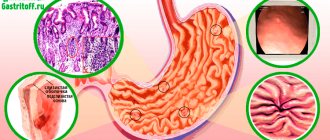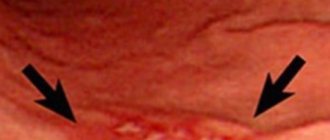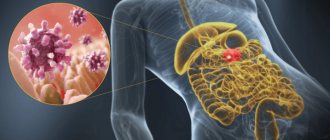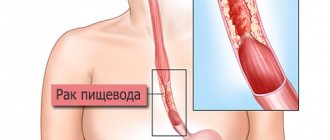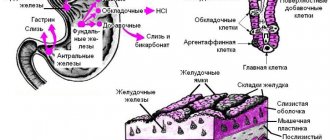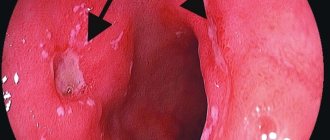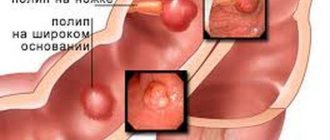Chronic gastritis in remission
The last stage of “remission” (otherwise called the inactive form of chronic gastritis) is characterized by smoothing of the relief of the walls of the human gastric mucosa, impaired secretory function and flattening of the epithelium.
At the described stage, the signs of the disease completely subside in the human body. It occurs only when a person has completely changed the rules and food, taken the necessary medications regularly, and undergone intensive physiotherapeutic treatment.
Possible complications and consequences
In addition, chronic gastritis can contribute to the development of diseases of the pancreas and gallbladder.
With proper and timely treatment, gastritis rarely causes complications. However, if left untreated, gastritis can cause serious health problems.
Erosive can cause the formation of peptic ulcers. Once an ulcer forms, it begins to gradually damage surrounding tissue. Severe ulcers can eventually cause internal bleeding, which can be life-threatening.
Other possible complications of chronic gastritis include:
- Anemia caused by iron deficiency;
- Anemia caused by internal bleeding;
- Vitamin B-12 deficiency;
- Abnormal growths in the stomach, such as polyps or tumors.
H. pylori infection. The most significant risk factor for developing gastritis is infection with the bacterium H. pylori. Although Helicobacter pylori infection is thought to occur in half the population, it is more common in developed countries. Most people do not have any signs or symptoms of H. pylori infection.
Regularly taking aspirin or other NSAIDs. If you regularly take aspirin to prevent a heart attack or stroke, you are at increased risk of developing gastritis.
The same goes for your use of anti-inflammatory pain medications to treat arthritis or other chronic conditions. Long-term use of aspirin and other NSAIDs may cause stomach irritation and bleeding.
Elderly age. Older people are at increased risk for developing gastritis because the lining of the stomach tends to thin with age and because older people are more likely than younger people to have H. pylori infection or autoimmune disorders.
If left untreated, gastritis can lead to the development of stomach ulcers and gastric bleeding. Some forms of chronic gastritis may increase your risk of developing stomach cancer, especially if you have widespread thinning of the lining of your stomach and changes in its cells.
Characteristic features of gastritis remission
At the stage of remission, the state of the body largely coincides with the early period of the disease - superficial gastritis. Modern medicine diagnoses chronic gastritis using a gastroscopy procedure. Main features:
- The mucous surface of the stomach is in most cases slightly thickened. With complete remission, the membrane returns to its normal state.
- The integumentary pitted epithelial tissue has dystrophic changes that are almost imperceptible. During the process of restoration of the body, the highly columnar epithelium is deformed into cubic epithelium and becomes flattened.
- The nuclei become hyperchromic and increase in size.
- Positive material indicating hypersecretion of the gastric lining is found above the cell nuclei in the cytoplasm.
- A mucous layer forms on the surface of the epithelial tissue.
- Suppression of secretion is rarely diagnosed.
- In the apical part of the cells, a mucoid appears in the form of a narrow, small strip. The number of RNAs increases significantly.
- A pronounced lymphoplasmacytic infiltration is noticed in the lamina of the human gastric mucosa.
- The remission stage is characterized by the intactness of the antrum and glands in the human body.
During the period of remission of the disease in the patient’s body, there is a complete or partial absence of signs of gastritis. Often manifests itself in people with chronic exacerbation of the disease. At this stage, the patient expects the possible completion of strict but effective measures for the treatment of chronic gastritis. Temporary prophylaxis and constant monitoring by the attending physician for possible exacerbation of the disease should not be ruled out.
Chronic gastritis in the remission stage takes different periods of time, from a week to decades - if a person follows the norms prescribed by the treating doctor. Then the course of remission depends entirely on the complex of treatment prescribed by the doctor.
Many aspects of recovery depend directly on the effectiveness of the recommendations and the abandonment of the patient’s aggravating bad habits. In the last stage of gastritis, it is necessary to minimize the obvious manifestation of symptoms and signs. A person takes a break from treatment for many years.
Forecast
With adequate treatment and follow-up, chronic gastritis does not lead to a significant deterioration in the patient’s quality of life. With atrophic changes in the gastric mucosa, the prognosis of the disease is less favorable.
Patients with chronic gastritis are advised to undergo regular examinations by a gastroenterologist twice a year. Regular endoscopic examination is recommended for patients at risk of malignancy.
The prognosis for recovery in the presence of a diagnosis of “chronic atrophic gastritis” depends on the age factor - in patients over 50 years of age, the risk of metaplasia and degeneration into cancer is higher. Leading importance is given to early diagnosis and treatment tactics. However, the asymptomatic onset of the pathology complicates the detection of gastropathy at a stage that can be successfully cured.
Preventive measures come down to organizing a balanced diet with a clear regimen, observing basic hygiene rules (washing hands) to reduce the risk of infection and foodborne diseases. An important role is played by timely response to complaints from the gastrointestinal tract, including pain, heartburn, and discomfort.
Exacerbation of chronic gastritis at the stage of remission
The remission stage, like other forms of chronic gastritis, alternates with the appearance of a sharp or gradual exacerbation of the disease. Let's consider the characteristic causes and symptoms of the process at the healing stage.
Characteristic reasons
Chronic gastritis is a long-term disease characterized by multiple deformations in the body. First of all, the affected organ is the gastric mucosa. For example, changes occur in the regeneration of epithelial cells of the glands. This causes gradual atrophy of the epithelium. Structural changes that progress in the mucous membrane occur along with many disturbances in the processes of the organ. Chronic gastritis can develop in the human body over a long period of time.
One of the most common causes of exacerbation of the disease is the penetration of harmful bacteria Helicobacter pylori into the human body. Microbes easily penetrate the gastric mucosa, multiplying at tremendous speed. According to medical workers, when the first symptoms of the disease appear, you need to contact a medical service. If no action is taken, the exacerbation will develop into a serious type of disease.
Few people notice the primary signs of this disease and do not seek medical help, continuing to lead their usual unhealthy lifestyle.
Violations of diet and eating habits play a huge role in exacerbating the disease. Even at the remission stage, doctors advise following a special diet consisting of hypoallergenic foods for several years. Many people break down and return spicy, salty, fatty foods to their diet, provoking an exacerbation of chronic gastritis.
A separate reason is considered to be the consumption of alcoholic beverages. Ethanol should not only be minimized, but completely eliminated from life. When drinking alcohol, the level of gastric juice increases due to an increase in the level of acidity in the human body.
Problems with the gums, teeth or oral cavity provoke an exacerbation. Anything that interferes with the process of chewing, swallowing and processing food harms the human gastric mucosa. For example, large pieces of food cause great damage to the human body. Try to visit your dentist periodically to avoid such troubles.
Smoking or taking medications plays a big role. Inhaling tobacco smoke, a person destroys the condition of the lungs, his own stomach, harmful chemicals settle on the mucous membrane. Anti-inflammatory drugs often cause complications in its work.
If the patient is an employee of an enterprise whose working conditions have a detrimental effect on health, one should not be surprised if exacerbations periodically develop, despite complete remission. Polluted air settles on the mucous membrane of the human stomach. Particles of dust, metal and harmful substances negatively affect the general condition. There is a possibility of their entry through the oral cavity during food intake.
During the remission stage, an exacerbation of the disease of chronic gastritis often begins. Signs and symptoms will allow you to detect the presence of the disease in the body during a period of long remission:
- If you feel heaviness in your stomach due to food intake;
- For a number of periods, pain appears in the epigastric zone;
- You experience heartburn and belching;
- Partial or complete loss of appetite.
The signs are subtle, often a person does not attach importance to them, and is saved by medication, drowning out the manifestations. Signs of gastritis do not appear constantly, but in periods, having a direct connection with diet. This means that inflammation of the gastric mucosa has not reached its climax. For example, smoked and fried foods, over-salted foods cause heaviness in the stomach, as do fast food products and carbonated water. Heartburn occurs after eating kefir or citrus fruits. This occurs due to increased acidity in the stomach. Overeating has a similar effect on the body. Then a feeling of fullness appears in the irritated gastric mucosa.
If signs of chronic gastritis appear periodically, but the exacerbation increases daily, chronic gastritis has reappeared in the human body. You should not delay going to a medical facility if you notice symptoms of the disease. If the first stage passes easily, the body may have already begun to develop a more serious form of the disease.
Despite the fact that remission implies a partial or complete cure, the likelihood of an exacerbation is high. It is important to seek medical help in time and begin preventive and phthisiatric procedures and take antibiotics.
Symptoms of the disease
Superficial gastritis at the initial stage of development is often asymptomatic. As inflammation of the gastric mucosa increases, the following symptoms appear:
- loss of appetite;
- heartburn;
- belching with the release of acidic stomach contents;
- aching pain in the epigastric region;
- heaviness in the stomach;
- increased gas formation;
- nausea;
- stool disorder.
When stomach pain reaches its peak, the patient may experience an attack of vomiting. After it comes temporary relief. As the disease progresses, increased fatigue and deterioration of general condition occur. If this type of gastritis occurs together with duodenitis, then the absorption of nutrients is impaired. This, in turn, leads to anemia.
Features of chronic gastritis
Chronic gastritis is preceded by an acute form of the disease. Acute gastritis is an inflammatory disease of the stomach, which is characterized by disruption of the functioning of the organ. The disease most often develops against the background of poor nutrition and infection with the bacterium Helicobacter pylori.
Without treatment, the acute disease becomes chronic. This is a long-term pathology characterized by stages of exacerbation and remission. In the International Classification of Diseases, superficial chronic gastritis is assigned the code K29.3, and other chronic forms - K29.6.
Remission and exacerbation: features of the stages
From Latin the word “remissio” is translated as “reduction.” The period of remission is characterized by a decrease or complete elimination of the symptoms of the disease. A distinction is made between complete and incomplete remission. In the first case, the symptoms of the disease disappear completely, the person is actually cured of the disease, nothing bothers him. In the second case, some symptoms persist, but their intensity is weak, they practically do not cause discomfort to the person. The remission stage is also called the inactive form of the disease.
What is needed for gastritis to become inactive?
In order for chronic gastritis to become inactive, acute disease is treated. A key role in therapy is played by medication and diet therapy. It is also important to observe the rules of personal hygiene, give up bad habits (quit smoking and not drink alcohol), eliminate stressors, and reduce physical and emotional stress.
Drug therapy includes taking several groups of drugs that normalize the condition of the gastric mucosa, relieve inflammation in it, eliminate dyspeptic symptoms, and improve the digestion process. If gastritis is infectious in nature, combinations of antibiotics are prescribed to destroy Helicobacter pylori infection in the stomach.
Important! Drug therapy may also be required during the remission stage of the disease. It is prescribed to prevent exacerbations and improve the general well-being of the patient. The need to take medications is determined by the type of disease, for example, with chronic atrophic gastritis in remission, replacement and stimulant medications are required.
Diet therapy is an important condition for getting rid of the disease. The patient has to give up many familiar foods, adjust their diet, and change their attitude towards food. Overeating must be excluded; meals are taken frequently, in small portions. This prevents high loads on the gastrointestinal tract, which makes it possible to reduce the inflammatory process in the mucous membrane.
The diet is aimed at protecting the stomach from mechanical, chemical and thermal irritants, which are spicy, sour, fatty, smoked, salty, too hot, cold, hard foods. The menu of a patient with gastritis includes semi-liquid, mushy, pureed dishes.
The consumption of juices, sodas, coffee and strong tea, and energy drinks is prohibited. Drinks allowed include herbal, green, weak black tea, still water, jelly, and compotes.
If an exacerbation develops and during the acute stage of the disease, it is recommended to observe therapeutic fasting in the first 2-3 days. This relieves severe stomach pain and improves the patient’s well-being.
We recommend that you find out why you can’t eat seeds if you have gastritis.
Find out what an abdominal ultrasound shows and how it is performed.
How to prevent aggravation?
In order for chronic gastritis to remain inactive for as long as possible and unpleasant symptoms not to reappear, it is important to follow all the recommendations of your doctor. If they are ignored and even minor flaws in the diet, an exacerbation of the disease may begin.
You can prevent exacerbation by leading a healthy lifestyle and following a diet. A healthy lifestyle means:
- presence of a daily routine;
- absence of bad habits (smoking, drinking alcohol);
- regular preventive examinations by specialists;
- timely treatment of existing diseases;
- regular moderate physical activity;
- no stress.
Doctors recommend that the oral cavity be sanitized by a dentist, since dental diseases can provoke diseases of the gastrointestinal tract. For people with gastroenterological pathology, it is important to periodically undergo endoscopic examination of the stomach to monitor the condition of the mucous membrane of the organ.
Atrophic gastritis, its treatment and symptoms
Our readers successfully use Monastic Tea to treat gastritis and ulcers.
Seeing how popular this product is, we decided to bring it to your attention. Read more here... Experiencing weakness, lethargy, apathy, many women attribute such symptoms to fatigue and nervous tension, and, watching how hair falls out and nails break, gums become inflamed, they think about a lack of vitamins in the body.
At the same time, they do not pay attention to periodically occurring stomach pains, considering poor quality nutrition to be the cause of their occurrence.
At the same time, such signs may indicate that a dangerous disease is developing in the body - chronic atrophic gastritis.
Why is it dangerous and what is the difference between atrophic gastritis and normal gastritis? How is atrophic gastritis treated correctly? Is it possible to completely recover from the disease?
How does atrophic gastritis proceed, symptoms and treatment in women. This article will provide answers to these questions.
Atrophic gastritis. Symptoms and treatment
In addition to the symptoms already mentioned, with atrophic gastritis there are others that are more characteristic of diseases of the digestive organs: heartburn and belching, bloating, stomach pain of various etiologies, a feeling of heaviness and fullness in the abdomen, a metallic taste in the mouth, weight loss.
In the case of an acute process that develops quickly, with increasing symptoms, nausea and vomiting, severe cramping pain in the stomach or solar plexus occurs, fainting and a rise in body temperature are possible.
In most cases, the disease becomes chronic and lasts a long time, with frequent exacerbations.
If the necessary measures are not taken in time, gastritis will slowly progress and in many cases it will be impossible to cure it completely.
If left untreated for a long time, malignant neoplasms can develop against the background of gastritis, therefore, if you discover signs of the disease, you should seek medical help as soon as possible.
What happens to the stomach when you get sick? Although the symptoms of atrophic gastritis in most cases do not differ from the symptoms of normal gastritis, the stomach tissues are affected to a much greater extent.
Partial or complete atrophy of the glands that participate in the production of gastric juice occurs, the protective mucous membrane becomes thinner, and the organ tissues lose their ability to recover.
The consequences of these factors are a lack of enzymes involved in the process of digestion and breakdown of food, as a result of which the body does not receive the required amounts of vitamins and microelements necessary for the normal functioning of all its systems.
In almost half of the cases of atrophic gastritis, a significant change in the structure of the gastric lining occurs, which in medicine is called metaplasia.
In advanced cases, when the disease progresses further, some of the stomach cells are replaced by intestinal cells, and in the future the inflammatory process can affect other organs of the gastrointestinal tract.
Types of atrophic gastritis
Chronic atrophic gastritis has two main types - autoimmune and bacterial.
- The autoimmune type is less common than the bacterial type. It is found in every tenth patient diagnosed with gastritis. The reasons for its appearance are varied, but the course is typical for all autoimmune processes: at a certain point, the human immune system begins to perceive the cells of its own body as foreign and produces antibodies to fight them. Autoimmune diseases are difficult to treat and a patient with this type of gastritis will need to undergo maintenance therapy throughout his life.
- Bacterial gastritis occurs under the influence of toxins produced by the Helicobacter pylori bacterium, which enters the body orally if hygiene rules are not followed.
Helicobacter bacteria are not sensitive to the acidic environment of the stomach; they can remain in the body for a long time without showing themselves, but under certain circumstances they become active and begin to destroy the gastric mucosa, causing gastritis.
In addition to the two main forms, medicine classifies several subtypes, each of which has its own characteristics:
- superficial gastritis - symptoms of superficial gastritis occur in 60-70% of people, the prognosis for it in many cases is favorable;
- focal - with this type of gastritis there is intolerance to milk and products made from it, including fermented milk, some types of meat, eggs. After taking even a small amount of these products, nausea and vomiting begin;
- multifocal – risk of cancer;
- chemical - develops when chemicals (arsenic, lead), dust from coal, metal, cotton constantly enter the human body;
- antral gastritis – characterized by morning sickness;
- hyperplastic – characterized by severe pain, internal hemorrhages, and possible degeneration of gastritis into cancer.
Chronic atrophic gastritis occurs the same in people of any sex, but in women of childbearing age, chronic gastritis with severe internal bleeding can cause iron deficiency anemia, since they also lose blood during menstruation.
Moreover, it is much more difficult for women over 50 to cure this disease than for men.
The difficulty lies in the fact that women often get carried away with various diets without consulting a doctor.
Such diets have an extremely negative effect on the digestive organs and make their treatment difficult.
Causes of atrophic gastritis
The causes of gastritis can be both external (autoimmune processes in the body, Helicobacter infection, genetic predisposition) and internal, which depend on the quality of nutrition and lifestyle of the person himself.
It is difficult to influence external causes, but by changing your diet to a healthier one and giving up bad habits, you can significantly speed up recovery and avoid complications of the disease.
What influences the development of atrophic gastritis?
- The human diet contains large quantities of animal fats, spicy snacks and spices, vinegar, mustard, horseradish, baked goods and sweets;
- excessive passion for alcoholic beverages, including beer, energy drinks and low-alcohol cocktails;
- the habit of not having breakfast, having a dry snack at lunch, and in the evening making up for lost time with large portions of food;
- prolonged uncontrolled use of medications, especially painkillers and sulfonamides;
- passion for diets without consulting a nutritionist;
- constant overeating, especially food that is heavy on the stomach;
- work in hazardous industries involving chemicals;
- gastritis often accompanies people with complexes, low self-esteem, and those exposed to constant stress and nervous tension in the family or at work.
Taking into account all these negative factors, people who are exposed to them should make adjustments to their lifestyle: change their diet to a healthier one, leave bad habits, change jobs, reconsider their attitude towards themselves, visiting, if necessary, a psychologist or psychotherapist .
You should also pay attention to the endocrine system, since its improper functioning can cause stomach problems.
Diagnosis and treatment of atrophic gastritis
To make a correct diagnosis, a gastroenterologist will prescribe an examination that will help determine the cause and type of gastritis, the possible presence of ulcers, atrophy and internal bleeding.
Diagnosis includes blood, stool, urine tests, X-ray and ultrasound examinations, FGDS.
The blood of a patient with gastritis is tested for antibodies to Helicobacter to determine their presence in the body, as well as to exclude or confirm the autoimmune nature of the disease.
During FGDS, the condition of the gastric mucosa is checked, and a biopsy is also performed to determine malignant degeneration.
Stool analysis will help identify internal gastric bleeding, and urine will be examined for possible concomitant pathologies.
Treatment is prescribed depending on the type of atrophic gastritis, taking into account the stage of the disease, area of damage, age of the patient and other diseases that he may have.
Treatment of autoimmune atrophic gastritis is long-term, often maintenance therapy must be carried out throughout life.
For such pathologies, drugs are often used that suppress the immune system in order to prevent it from destroying the cells of its own body.
Treatment with immunosuppressants is associated with great risk, since suppression of the immune system deprives a person of the ability to fight viruses and bacteria and increases the risk of various diseases, including cancer.
In some cases, a plasmapheresis procedure is prescribed: the patient’s blood is passed through a special device, in which it is cleansed of abnormal antibodies and enters back into the patient’s bloodstream.
Treatment of atrophic gastritis caused by Helicobacter is carried out with the help of special antibacterial drugs, such as Amoxicillin, Metronidazole; without their use, other methods of treatment will be ineffective and will alleviate the symptoms of the disease only for a short time.
Antibacterial therapy usually lasts 10 days.
In addition to specific, for all types of atrophic gastritis there is standard treatment according to the medical protocol:
- Painkillers: anticholinergics - Platifilin, Histodil, Gastrocepin, prescribed for pain in the stomach, esophagus, and solar plexus area. These medications are not intended for long-term use, as they irritate the mucous membranes and are addictive.
- Proton pump inhibitors to block the formation of hydrochloric acid (Omeprazole, Esomeprazole, Rabeprazole).
- Antacids - Almagel, Phosphalugel, Gastal, Gaviscon, Rennie, taken for heartburn.
- Prokinetics - improve gastric motility (Motilium, Domperidone, Domrid, a new generation drug - Metoclopromide).
- Preparations that promote the production of enzymes or contain them in finished form: Limontar, Pancreatin, Mezim, Creon, pepsin.
- If gastritis is accompanied by anemia, iron-containing drugs are prescribed: Ferroplex, Ferrum Lek, Sorbifer, iron gluconate, as well as vitamin B12 intramuscularly.
- Sometimes physiotherapeutic procedures are indicated: electrophoresis, exposure to magnetic radiation or electric field.
In most cases, atrophic gastritis cannot be treated surgically. Surgery is indicated only in cases of severe internal bleeding.
How long the treatment will take depends on the stage and type of gastritis, in some cases it will take several weeks to cure, in others, when gastritis has become chronic, it is completely impossible to cure.
Atrophic gastritis can also be treated with traditional methods, after consulting a doctor. For this, medicinal herbs are used (chamomile, yarrow, centaury, coltsfoot), honey with aloe, flaxseed, vegetable and essential oils.
Treatment with folk remedies is long-term, carried out in courses of 3-4 weeks with a month's break. Homeopathic remedies can also be used.
With atrophic gastritis, you must follow a diet.
You will have to forever give up fried, spicy, fatty and smoked foods, baked goods and confectionery products, carbonated and alcoholic drinks, cocoa, coffee, chocolate, ready-made breakfast cereals, and semi-finished products.
Our readers successfully use Monastic Tea to treat gastritis and ulcers. Seeing how popular this product is, we decided to bring it to your attention. Read more here...
For gastritis of any kind, a split meal regimen must be followed; its temperature is also important; excessively hot or cold food can irritate the walls of the stomach.
Breaks between meals should be as equal as possible; overeating is unacceptable.
Some people, afraid of provoking the symptoms of gastritis, deliberately refuse to eat, which is very dangerous, because dystrophy occurs and the body does not receive enough of the nutrients it needs.
Chronic gastritis is not a reason to give up your favorite foods, only the method of preparing them should be changed.
Instead of frying and baking until golden brown, food can be boiled in water or steamed, stewed, baked in foil, or cooked in a slow cooker.
Allowed products and dishes made from them:
- lean meat of chicken, rabbit, turkey (boiled, in the form of pates, soufflés, steamed cutlets and meatballs);
- vegetable and cereal soups;
- vegetables after heat treatment (steamed, stewed, baked with the addition of a small amount of butter or cream);
- low-fat milk and fermented milk products;
- vegetable, cereal and cottage cheese casseroles, puddings;
- steam omelette or soft-boiled egg;
- jelly and jelly from non-acidic fruits;
For sweets, you can eat a little natural marmalade, marshmallows, marshmallows, honey, no more than 2-3 times a week.
Having been diagnosed with atrophic gastritis, you can lead a normal, fulfilling life if you follow medical recommendations.
Useful video
Chronic gastritis
Sections on the diagnosis and treatment of chronic gastritis are written in accordance with the Federal Standard for the provision of medical care for chronic gastritis. Moderator - Polukhina A.V., practicing therapist.
Gastritis is a disease characterized by changes in the gastric mucosa and accompanied by various disorders of its basic functions.
Chronic gastritis affects 50-80% of the entire adult population, and the incidence of gastritis increases with age.
- Microbial: Helicobacter pylori and other microbes
- Non-microbial: autoimmune, alcoholic, after gastric surgery, due to exposure to anti-inflammatory drugs (for example, indomethacin, ibuprofen, aspirin, etc.), due to exposure to chemicals
- Unknown factors, incl. microorganisms.
Chronic non-atrophic gastritis in 85-90% of cases is caused by the microbe Helicobacter pylori.
The development of chronic atrophic (autoimmune) gastritis is associated with the genetically determined production of autoantibodies to the cells of the gastric mucosa.
The most common causes of chemical (reactive) gastritis are the reflux of bile from the intestines into the stomach and long-term use of certain medications.
The causes of eosinophilic gastritis are unknown; in some patients, bronchial asthma, eczema and other allergic diseases are detected.
Granulomatous gastritis is found in 10% of patients with sarcoidosis, 7% of patients with Crohn's disease, with tuberculosis, mycoses, and foreign bodies in the stomach.
The cause of giant hypertrophic gastritis is unknown.
- Pain in the epigastric region that occurs on an empty stomach. The pain can be acute, cramping or aching, not intense; sometimes occur soon after eating
- Heartburn, sour belching, less often nausea, vomiting of gastric contents.
- The most common manifestations of chronic gastritis are heaviness in the epigastric region after eating, a feeling of overeating, fullness of the stomach, belching of food and air, an unpleasant taste in the mouth, decreased appetite, possible flatulence, unstable stool
- Vomiting and diarrhea are possible; appetite is often reduced
- A general blood and urine test will help detect signs of an inflammatory process in the body during exacerbation of chronic gastritis (in remission, tests will be normal), hyperchromic anemia in chronic autoimmune gastritis.
- Stool analysis: possible presence of hidden blood, as well as undigested food debris with reduced secretory activity of the stomach.
- FGDS and taking biopsies for histological examination. If it is impossible to perform FGDS, an X-ray examination of the stomach with barium contrast can be performed, but this is less informative.
- Study of the secretory function of the stomach.
- Identification of the microbe Helicobacter pylori. The “gold standard” is a histological examination of biopsy specimens with their staining according to certain schemes and subsequent microscopic examination. A biological method is also used (seeding a microorganism on a nutrient medium).
- Manometry: with reflux gastritis, an increase in pressure in the duodenum to 200-240 mm water column is detected. (normally - 80-130 mm water column).
Differential diagnosis is carried out with peptic ulcer of the stomach and duodenum, diaphragmatic hernia, esophagitis, and tumors.
FGDS is crucial for clarifying the diagnosis.
You can check the Russian Federation Standard of Medical Care for Chronic Gastritis, in accordance with which this article was written.
Treatment of chronic gastritis caused by H. pilory
For gastritis caused by the microbe Helicobacter pylori, antimicrobial therapy is used.
There are several standard treatment regimens, including
- antibiotics,
- PPI (omez, nolpaza, pariet, emanera - substances used in the treatment of gastrointestinal diseases associated with the release of hydrochloric acid),
- bismuth preparations (de-nol, ventrisol).
What causes gastritis in older people?
Acute gastritis in older people develops as a result of ingesting poor-quality infected food, mistakenly consuming strong solutions of acids or alkalis, and improper and long-term use of medications (salicylates, reserpine, corticosteroids, cardiac glycosides).
Among the causes of the development of chronic gastritis, exogenous and endogenous can be distinguished. Exogenous factors are dietary disorders, consumption of poorly processed rough foods, long-term use of medications. Among the endogenous causes are neurovegetative disorders, neuroreflex effects in diseases of other organs, lesions of the pituitary-adrenal system, chronic infectious diseases, metabolic disorders, hypoxia of gastric tissue in chronic cardiovascular, respiratory, renal failure, allergic diseases.
Damage to the gastric mucosa in chronic gastritis: superficial (initial phase), with damage to the glands without atrophy (intermediate phase) and atrophic (final phase). In contrast to young people, atrophic bacterial (type B) is most common in elderly and old people.
Remission of chronic gastritis: features of treatment of the disease
The relevance of chronic gastritis in the modern world is very high; the disease affects not only the elderly, but also young people. Moreover, every year doctors record the “rejuvenation” of patients. Based on medical statistics, up to 80% of the world's population suffers from this disease.
If not treated in a timely manner, gastritis becomes chronic, which leads to smoothing of the mucous membrane, disruption of secretory function, and flattening of the epithelium. Often this stage can occur without symptoms, only if the patient still takes advantage of complex therapy, changes his diet and gives up bad habits.
Why does gastritis not go away completely?
Is it possible to completely cure chronic gastritis? If the disease is not treated, then there is no point in talking about a positive result.
In the case when a patient is being treated at home for a long time, and the result is not at all what he expected, it is advisable to consult a doctor.
Moreover, the treatment process can be protracted if gastritis is advanced. Therefore, it is advisable to have patience and strength. Sometimes it is necessary to undergo a second course of treatment.
In some cases, it is necessary to additionally use folk recipes.
It is recommended that, after the exacerbation has passed, treatment in a sanatorium with the use of special mineral water.
It is necessary to treat gastritis, even if it does not go away for a long time. If no measures are taken, it can gradually develop into an ulcer.
Then it can even turn into oncology.
Characteristic features of the disease
Chronic gastritis in remission is similar in condition to a patient with a superficial form of the disease, which is the early period of the disease. To diagnose this type of disease, the gastroenterologist refers the patient to a gastroscopy procedure. At this time, the following is observed in the patient’s body:
- the gastric mucosa has a thickening, and with complete remission, the lining acquires a natural state;
- dystrophic changes have affected the integumentary pitted epithelial tissue, but this is practically not visible;
- the nuclei acquire a larger size and become hyperchromic;
- positive material is located above the cell nuclei in the cytoplasm;
- there is a layer of mucus on the surface of the epithelial tissue;
- the amount of RNA is significantly increased.
In the inactive stage of the disease, the patient has completely or partially no signs of the disease. The patient can stop strict measures aimed at treating the disease. But it is very important to understand that you will still have to carry out preventive measures and be constantly monitored by your doctor. This is necessary to prevent exacerbation.
Patients are often interested in what it is – remission of chronic gastritis. Doctors call this long-term illness the last stage of gastritis. It is important to realize that only effective recommendations from specialists will help minimize the manifestation of the disease.
Causes of exacerbation
A chronic disease can develop in the body over a long period of time. Doctors attribute Helicobacter pylori to the main causes of exacerbation of the disease. After the bacteria penetrates the mucous membrane, it actively multiplies.
A special diet plays an important role during the inactive stage of the disease. Gastroenterologists believe that the patient should adhere to a diet for several years. Often those suffering from gastritis break down and return to their usual diet; this also provokes an exacerbation of the chronic form of the disease.
Important! When diagnosing this serious illness, doctors advise completely abstaining from alcohol, since its consumption, even in minimal quantities, leads to an increase in the level of acidity in the stomach.
Also factors influencing exacerbation are problems with teeth, oral cavity, smoking, frequent use of medications, and polluted air.
Diagnostics
Identification of the disease in question includes a number of examinations, both laboratory and instrumental. Patients undergo a blood test for general and biochemical parameters. Leukocytosis and an increase in ESR will help identify pathology. An important blood indicator is the level of bilirubin and protein, as well as transaminase.
Instrumental examination methods include:
- Ultrasound examination of internal organs. Necessary for differential diagnosis.
- Fibrogastroduodenoscopy (FGDS). Allows you to identify all changes and defects on the surface of the gastric mucosa.
- Breath test. It is carried out to detect the presence of Helicobacter pylori in the stomach.
Based on these data, the extent of spread of superficial antral gastritis is determined. The disease can be mild, moderate or severe.
Symptoms
After a long remission, the patient can recognize the process of exacerbation by the following symptoms:
- after eating food there is a feeling of heaviness;
- periods of pain occur;
- belching and heartburn;
- loss of appetite.
These sensations are implicit, so the patient may not attach any significance to them and only resort to taking medications to drown out the symptoms. An important point that experts note is that the periods of symptoms are not constant and are associated with diet. This suggests that the inflammatory process of the mucous membrane has not reached its climax. For example, when eating fried, salty foods, heaviness occurs, and heartburn appears after the patient drank kefir or ate citrus fruits. This diet increases acidity. We can talk about the return of a chronic disease only after a daily increase in the manifestation of symptoms.
Clinical picture
It is impossible to clinically distinguish one form from another or make a diagnosis at all. Among all the manifestations, there is not a single pathognomonic (i.e., characteristic only of this disease) symptom. The same signs of chronic gastritis may indicate another pathology of the gastrointestinal tract.
Symptoms are variable and range widely from a latent (hidden) course to a severe exacerbation with a polymorphic clinical picture. This largely depends on the form of the disease and the individual characteristics of the patients.
During exacerbation, the following symptoms of chronic gastritis may occur:
- Pain is considered the dominant symptom, since it is its appearance that usually prompts people to consult a doctor. Determined in the upper abdomen and left hypochondrium immediately or 30 minutes - 1.5 hours after eating;
- Appetite gradually disappears;
- There may be belching or heartburn;
- Nausea up to vomiting with traces of blood (“coffee grounds”);
- The occurrence of unpleasant sensations or rapid filling;
- Bloating;
- Signs of anemia: increased fatigue, flashing “spots” before the eyes, pale skin, angular stomatitis (cracks in the corners of the mouth), brittle nails and hair.
- Neurosis.
Treatment of chronic illness
When the patient detects symptoms in a timely manner and treatment is prescribed immediately, the disease can be dealt with quickly. The remission stage implies complete or partial recovery, but once hearing this diagnosis, the patient should not relax, since the likelihood of exacerbation is high.
Treatment of the disease should be carried out under the supervision of a specialist who prescribes competent therapy based on the characteristics of the disease. Approximate drug treatment:
- calcium carbonate, magnesium oxide and bismuth nitrate have an astringent effect when taken together;
- antacid and enveloping drugs are used before meals - Almagel, Phosphalugel, Almagel A;
- to heal erosion, use silver nitrate in the form of a 0.06% solution, as well as Vinilin;
- antispasmodics – No-shpa, Papaverine, Galidora;
- for the stability of the mucosa in the erosive form of the disease, cytoprotective agents are prescribed - Skuralfat, Denol;
- enhance acid secretion Plantaglucide, plantain juice;
- natural gastric juice will become an indispensable aid for antacid gastritis - Betacid, Acidinpepsin;
- Antibacterial therapy when Helicobacter pylori is detected - Omeprazole, Lanzoprazole, Clarithromycin, Metronidazole, Amoxicillin.
Diet for illness
The patient will adhere to dietary nutrition throughout his life, after the doctor, based on diagnosis, confirms a serious disease - gastritis. Meals should be fractional, up to six times a day, with small portions. Before prescribing a diet, the gastroenterologist pays attention to the acid-forming functions of the stomach. If the acidity level is high, it is recommended to exclude alcohol, pickles, canned food, strong meat and fish broths, seasonings, strong tea, coffee, and carbonated drinks. The diet should include: dry cookies, milk soups, cereals, pasta, boiled meat, fish, stewed vegetables, jelly, jelly, cocoa.
Antacid gastritis, characterized by low acidity, involves the use of foods that stimulate gastric acid secretion. For example, stale rye bread, water porridge, soft-boiled eggs, cheese, fresh juices, apples, lean meat and fish, and black caviar are suitable for this type of disease. Fresh baked goods, brown bread, cabbage, grapes, spicy foods, and cold drinks are prohibited, as they take a long time to digest and irritate the mucous membranes.
The danger of chronic gastritis lies in the fact that few patients notice the primary signs and turn to specialists; most often, patients continue to lead their usual lifestyle, aggravating their disease. But with timely treatment, this disease is not a death sentence. Remember, we are responsible for our health!
Proper nutrition
A balanced diet is the basis for the treatment of superficial antral gastritis. Patients must adhere to the following rules:
- fractional meals in small portions 5-6 times a day;
- food should not be hot or cold;
- during an exacerbation, it is better to eat pureed and chopped foods;
- exclude hot sauces and seasonings, pickles and marinades, fatty and fried foods, smoked foods;
- quitting smoking and alcohol;
- maintain a drinking regime and drink at least 1.6 liters of water per day.
The preferred methods of preparing dishes for patients should be stewing, baking, boiling and steaming. During the period of exacerbation, you must strictly follow the diet. The ban also applies to sour berries, strong coffee or tea, carbonated drinks and fruit juices.
The diet of a person suffering from antral gastritis should consist of pureed and slimy vegetarian soups, fish and low-fat meats, cream and milk of minimal fat content, pureed porridges. You need to stick to the diet for several months until recovery occurs or symptoms disappear.
Features of chronic gastritis
Chronic gastritis is preceded by an acute form of the disease. Acute gastritis is an inflammatory disease of the stomach, which is characterized by disruption of the functioning of the organ. The disease most often develops against the background of poor nutrition and infection with the bacterium Helicobacter pylori.
Without treatment, the acute disease becomes chronic. This is a long-term pathology characterized by stages of exacerbation and remission. In the International Classification of Diseases, superficial chronic gastritis is assigned the code K29.3, and other chronic forms - K29.6.
Remission and exacerbation: features of the stages
From Latin the word “remissio” is translated as “reduction.” The period of remission is characterized by a decrease or complete elimination of the symptoms of the disease. A distinction is made between complete and incomplete remission. In the first case, the symptoms of the disease disappear completely, the person is actually cured of the disease, nothing bothers him. In the second case, some symptoms persist, but their intensity is weak, they practically do not cause discomfort to the person. The remission stage is also called the inactive form of the disease.
This stage of the disease can last a long time, up to several years. But for this, the patient must follow all the doctor’s recommendations and avoid dietary errors. At any moment, the inactive form can go into the acute stage.
In terms of its symptoms, the exacerbation is similar to the acute form of the disease. A person suffers from stomach pain, nausea and vomiting, stool disorders and other dyspeptic symptoms. When the disease worsens, complex therapy is carried out, the goal of which is to achieve remission.
How does the remission stage manifest itself?
Chronic gastritis in the inactive phase has characteristic features that are determined during gastroscopy:
- the gastric mucosa is thickened (if remission is complete, the mucous membrane looks healthy);
- dystrophic changes in the integumentary pit layer are subtle;
- epithelial tissue is covered with a mucous layer;
- secretion of gastric juice is not reduced;
- the nuclei are enlarged and hyperchromic;
- the amount of RNA increases.
We recommend finding out why a burning sensation in the stomach may occur.
What is needed for gastritis to become inactive?
In order for chronic gastritis to become inactive, acute disease is treated. A key role in therapy is played by medication and diet therapy. It is also important to observe the rules of personal hygiene, give up bad habits (quit smoking and not drink alcohol), eliminate stressors, and reduce physical and emotional stress.
Drug therapy includes taking several groups of drugs that normalize the condition of the gastric mucosa, relieve inflammation in it, eliminate dyspeptic symptoms, and improve the digestion process. If gastritis is infectious in nature, combinations of antibiotics are prescribed to destroy Helicobacter pylori infection in the stomach.
Important! Drug therapy may also be required during the remission stage of the disease. It is prescribed to prevent exacerbations and improve the general well-being of the patient. The need to take medications is determined by the type of disease, for example, with chronic atrophic gastritis in remission, replacement and stimulant medications are required.
Diet therapy is an important condition for getting rid of the disease. The patient has to give up many familiar foods, adjust their diet, and change their attitude towards food. Overeating must be excluded; meals are taken frequently, in small portions. This prevents high loads on the gastrointestinal tract, which makes it possible to reduce the inflammatory process in the mucous membrane.
The diet is aimed at protecting the stomach from mechanical, chemical and thermal irritants, which are spicy, sour, fatty, smoked, salty, too hot, cold, hard foods. The menu of a patient with gastritis includes semi-liquid, mushy, pureed dishes.
The consumption of juices, sodas, coffee and strong tea, and energy drinks is prohibited. Drinks allowed include herbal, green, weak black tea, still water, jelly, and compotes.
If an exacerbation develops and during the acute stage of the disease, it is recommended to observe therapeutic fasting in the first 2-3 days. This relieves severe stomach pain and improves the patient’s well-being.
We recommend that you find out why you can’t eat seeds if you have gastritis.
Find out what an abdominal ultrasound shows and how it is performed.
How to prevent aggravation?
In order for chronic gastritis to remain inactive for as long as possible and unpleasant symptoms not to reappear, it is important to follow all the recommendations of your doctor. If they are ignored and even minor flaws in the diet, an exacerbation of the disease may begin.
You can prevent exacerbation by leading a healthy lifestyle and following a diet. A healthy lifestyle means:
- presence of a daily routine;
- absence of bad habits (smoking, drinking alcohol);
- regular preventive examinations by specialists;
- timely treatment of existing diseases;
- regular moderate physical activity;
- no stress.
Doctors recommend that the oral cavity be sanitized by a dentist, since dental diseases can provoke diseases of the gastrointestinal tract. For people with gastroenterological pathology, it is important to periodically undergo endoscopic examination of the stomach to monitor the condition of the mucous membrane of the organ.
Causes and risk factors
Vote
Factors that increase the risk of developing gastritis include:
- Bacterial infection. Infection with the bacteria Helicobacter pylori is one of the most common infections in the world. Despite this, gastritis and infection-related ulcers develop only in some infected people. Scientists believe that vulnerability to these bacteria in some people is due to hereditary factors, as well as lifestyle factors such as smoking and severe stress.
- Long-term use of painkillers. Popular pain medications such as aspirin, ibuprofen, and naproxen can lead to the development of acute or chronic gastritis. Long-term use of these medications or use of them in large dosages may reduce the content of the substance that maintains the protective lining of the stomach. The likelihood of gastritis and other stomach diseases is reduced if you take these painkillers infrequently. Paracetamol does not lead to the development of gastritis.
- Age. The risk of developing gastritis increases with age. As a rule, this is due to the fact that with age the gastric mucosa becomes thinner, increasing the risk of Helicobacter pylori infection and autoimmune diseases.
- Alcohol abuse. Alcohol can irritate the lining of the stomach, making it more vulnerable to stomach acid. Consumption of alcohol in large quantities increases the risk of acute gastritis.
- Stress. Severe stress associated with surgery, trauma, burns or severe infection can cause acute gastritis.
- Autoimmune gastritis. Autoimmune gastritis develops when the body's immune system begins to attack the cells that make up the gastric mucosa, which is designed to protect the stomach walls from the aggressive effects of stomach acids. The risk of autoimmune gastritis is higher in people with other autoimmune diseases, such as autoimmune thyroiditis (Hashimoto's disease) or type 1 diabetes. Autoimmune gastritis may also be associated with vitamin B12 deficiency.
- Other diseases and conditions. The development of gastritis may be associated with other diseases, including HIV/AIDS, parasitic diseases and Crohn's disease.


